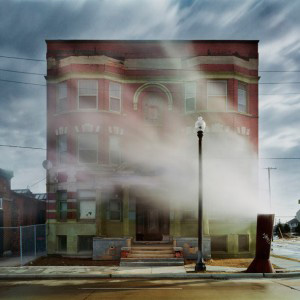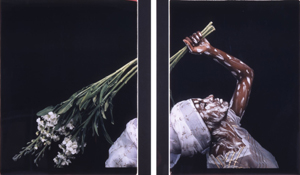1.3.24 — A Shot of Whiskey
When an artist leaves the big city for the Hudson River Valley after thirty-nine years, he might be in search of a new life. For Andrew Moore, it was just another good reason to pick up his camera and revisit American art.
Four years later, it is a show in Chelsea as well, as “Whiskey Point and Other Tales,” at Yancey Richardson through January 6. It should have anyone asking where he has been all these years and what he has found. It could be a stage in his life or a point of origins for American art.  Now in his sixties, he is still on the lookout for both—and I work this together with past reports of photography in the city and country as a longer review and my latest upload.
Now in his sixties, he is still on the lookout for both—and I work this together with past reports of photography in the city and country as a longer review and my latest upload.
It might seem a strange move. Thirty-nine years is a long time, long enough for many a career and long enough, too, to mark him as a city boy. Past series have taken him to Times Square theaters and the factories of Detroit. And the first thing he did after his student days was to head for New Orleans to record patterns of change in urban life. Come to think of it, many of those factories had fallen into disuse or decay since Charles Sheeler painted and photographed them starting in 1927, and Moore took care to compare and contrast their views. Decay will always have its appeal as the picturesque, but Moore knows enough to temper sentiment with precision.
Still, he had left town before to photograph the Great Plains, and he cites the influence of his great-great-grandfather, an artist who followed the course of the American railroad. As that suggests, he might wonder, too, if he had at last returned home. He grew up in one of the fanciest parts of Connecticut, and now he had moved up the Hudson to the Catskills, where residents relish their distance from the city. As a rural dweller might boast, he might even wonder if he had found paradise. It might have helped that he moved just in time to escape shuttered galleries after Covid-19. At the very least, his latest could pass for a fantasy.
Could clouds take on the deep reds of sunset in broad daylight, and could they descend anywhere like this, like jigsaw pieces to fit the buildings below? Could mists nestle into a valley as if arising spontaneously from the ground, much as they enveloped houses in Moore’s Detroit? Other mists deepen a grove of bare trees, while lending branches a perplexity of line and color. More light glows on the waters behind them, while other photos make it hard to know what is water and what sky. Sheep cluster for protection beneath more bare trees, while a dog keeps its distance. The dog knows enough to herd them while letting them feel free.
Like a proper paradise, this one has little need for people, but it does have room for him. Moore seems to have found a way to photograph himself at a fair distance as well, immersed in the stillness of landscape, but no: he had spotted a fellow explorer behind a camera overlooking a lake. Was it a follower of the Hudson River School updated for art’s media today? (The gallery cites a woman known for fantastic light and colors, Susie M. Barstow, along with Thomas Cole, Frederic Edwin Church, and Asher B. Durand in the nineteenth century.) Appropriately enough, Moore shares the gallery with Yamamoto Masao from Japan, whose spooky creatures depend on old-fashioned glass negatives.
So what has he been doing all along? For starters, he has always had a weakness for utopias, like old accounts of blue collar America and the settling of the American West, but with awareness of how things can go wrong. Other series have taken him to Cuba and Russia, with failed utopias of their own. For another, he has often found those utopias in past American art. Last, he sees in them an interchange between past and present. You may not need a shot of whiskey before joining the interchange—and settling into the confidence of wealth and class.
Read more, now in a feature-length article on this site.
